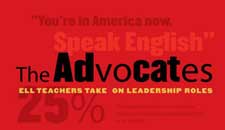 |
|||
| College of Education Home | News & Events | Make a Gift | UW Alumni | |||
|
November 2010 | Return to issue home
Making Connections Outside the Classroom
By the year 2025, nearly 25 percent of school-age children in America will be English language learners. Hard questions and often contentious debate surround the topic of how best to educate them. Should these students be taught simultaneously in their native language and English? Should they be taught first in their native language, then eased into English? Which native language: Urdu, Chinese, Spanish, Cambodian, Tagalog? Or should these students be plunged into mainstream English-only classrooms and left to sink or swim? Will teachers in those classrooms have to slow down teaching to accommodate struggling English language learners (ELL)? What happens to ethnic language and ethnic culture when students are moved into the monolingual mainstream? And what kind of social isolation occurs when they aren't? It's a contested field, surrounded by noisy politics—some of it not too pretty, with xenophobic cries to "Go back to where you came from" or "You're in America now. Speak English" aimed at immigrant and non-immigrant students alike. With no clear federal definitions of who is or isn't an English language learner, no standardized requirements for certifying ELL teachers, and no official U.S. policy guiding instruction—other than the federal mandate to provide it—states and districts are all over the map on how best to proceed. "If you really get to the heart of what people believe about English language learning, and when that gets tied to politics, ideology, and economics, you're going to have these fractured understandings of things," says UW associate professor Manka Varghese, whose research focuses on how to make instruction for culturally and linguistically diverse students more equitable and valuable. What she has seen, consistently, is the marginalization of both students and the teachers trying to help them. "The marginalization is a status issue and an advocacy issue," she says. "Why does the field of special education have so much more legislation? Many say it's because special education parents tend to be strong advocates. And families of ELL students have not been able to do that work historically. They don't have the language or the status." Varghese's research suggests the field is ripe for strong leadership. One interesting place she has seen it emerge is within the ranks of ELL teachers themselves. Her studies cite examples of teachers who become fierce champions of low-status students. They take on administrative roles to get what they need for ELL students, selecting instructional methods, programs, and materials for schools. They become school leaders, ELL coaches, public spokespeople, and, in the void of consistent language policy, they help frame the debate over English language learning. Fast facts on English language learners and teachers
November 2010 | Return to issue home |
|||
|
|||
